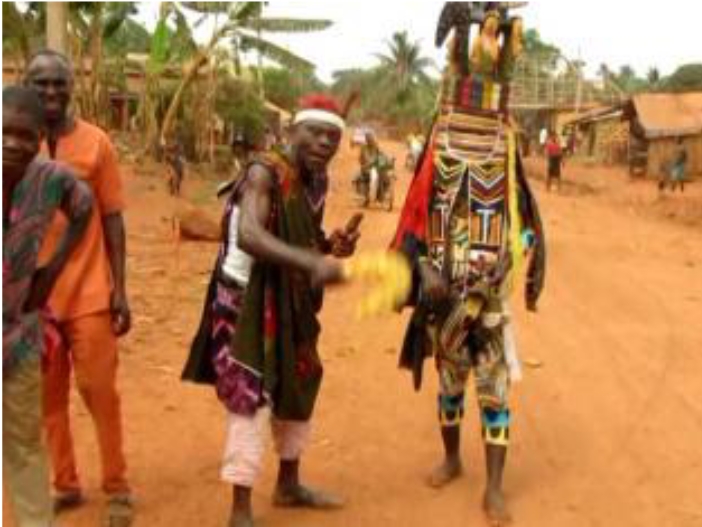Social Dynamics and Resilience in the Northern Igbo Masking Traditions
DOI:
https://doi.org/10.55121/card.v2i2.36Keywords:
resilience, social dynamics, northern Igbo masking tradition, liminality, Music composition and performanceAbstract
In the coming of the Europeans into Igbo land engendered change-producing forces,their encounter with the indigenous people created liminality that disrupted vital facets of Igbo traditional life. Masquerades that formed a significant aspect of the Igbo cultural heritage was hit the hardest by the colonial encounter but comparably changed the least. Participant to observation method was used to collect information for this study,it identified a few of the change-producing forces and tried to understand the reasons for the resilience of the masquerade institution in the face of a barrage of the forces of the agencies of modern social change ranged against it. Their effects have been enormous but because the Igbo people have profound belief in masquerades as the spirits of their ancestors personified, and that the links and relationships between them need to be maintained and sustained, and the institution continues to thrive. More so, masquerade engages the services of different artisans at every stage of its production and performance.
References
[1] Asogwa, O., Odoh, G., 2022. Problematizing the Dominant Narrative on Women’s Involvement in Igbo Masking Traditions. Journal of Asian and African Studies. pp. 1-9. DOI: https://doi.org/10.1177/00219096221079333
[2] Duerden, D., 1974. African Art: An Introduction. London: Hamlyn Publishing Group Limited.
[3] Egwuda-Ugbeda, F., 2003. The Role of Art, Science and Technology in African Masquerade Performance: A Macro View of Akwujane Masquerade of Igala. Njoku, O.N. (ed.). Nsukka Journal of Humanities. 13, 356-364.
[4] Cole, H., Aniakor, C., 1984. Igbo Arts, Community and Cosmos. Los Angeles: UCLA.
[5] Asogwa, O., Odoh, G., 2021. Reappraising the Iconography and Ethno-aesthetics of Adada Masquerade of the Nsukka Igbo, Southeast Nigeria. Cogent Arts & Humanities. 8(1). DOI: https://doi.org/10.1080/23311983.2021.1909221
[6] Enugu State Ministry of Information and Culture, 1993. Mmanwu Festival. Enugu: The Government Press. pp. 6-7.
[7] Emeka, L.N., 1974. The Soul of the Village Folk. Lagos: Voice of Nigeria Radio Broadcast.
[8] Asogwa, O., 2017. Masquerade Institutions in Africa: The Social Dynamics of Creativity and Resilience in Igbo Masking Traditions. An abstract of a paper presented at 2017 Annual Meeting of the African Studies Association at Basel, Switzerland. papers.ssrn.com
[9] Meek, C.K., 1930. Ethnographical Report on the Peoples of Nsukka Division, Onitsha Province. Lagos: Lagos Government Printers.
[10] Onyeneke, A.O., 1987. The Dead among the Living: Masquerades in Igbo Society. Enugu: Chuka Printing Co. Ltd.
[11] Redfield, R., 1941. The Folk Society. American Journal of Sociology. 52, 293-308.
[12] Emeka, L.N., 1993. The Metaphysical Technology. Enugu State Mmanwu Festival (Brochure). Enugu: The Government Press. pp. 19-29.
[13] Amankulor, J.N., 1981. The Art of Drama in Traditional African Theatre: Issues and Concepts. The Muse, Journal of Literary Studies, Department of English Language and Literary Studies, University of Nigeria, Nsukka.
[14] Ugwu, I., 2003. History, Mythology and Theatre of Social Conscience: An Example of Meki Nzewi’s The Lost Finger. Njoku, O.N. (ed.) Nsukka Journal of Humanities. 13, 81-94.
[15] Ijomah, B.I.C., 1986. The Origin and Philosophy of the University. E. Obiechina et al (eds.) University of Nigeria, 1960–1985: An Experiment in Higher Education. Nsukka: University of Nigeria Press Ltd. pp. 1-11.
[16] Nzekwu, O., 1966. Before the British police in Nigeria. Nigeria Magazine. 89, 102-116.
[17] Echeruo, M.J.C., 1973. The Dramatic Limits of the Igbo Rituals. Research in African Literature. 4(1), 21-31.
[18] Aniakor, C., 1978. The Igbo Ijele Mask. African Arts. XI(4), 42-47.
[19] Dmochowski, Z.R., 1990. An Introduction to Nigerian Traditional Architecture, Vol. Three: South-Eastern Nigeria, The Igbo-Speaking Areas. Lagos: ETHNOGRAPHICA Ltd.
[20] Okeke, U., 1985. University of Nigeria’s Initiatives in Nigerian Art Culture. Onyeneke, A.O. (ed.) Ikoro: Bulletin of the Hansberry Institute of African Studies, University of Nigeria, Nsukka. VI(2), 17-20.
[21] Wingert, P.S., 1962. Primitive Art: Its Tradition and Styles. New York: Oxford University Press.
[22] Fosu, K., 1986. 20th Century Art of Africa. Zaria: Gaskiya Corporation Limited.

Downloads
How to Cite
Issue
Section
License
Copyright (c) 2022 Odoja Asogwa

This work is licensed under a Creative Commons Attribution 4.0 International License.

 Make a Submission
Make a Submission